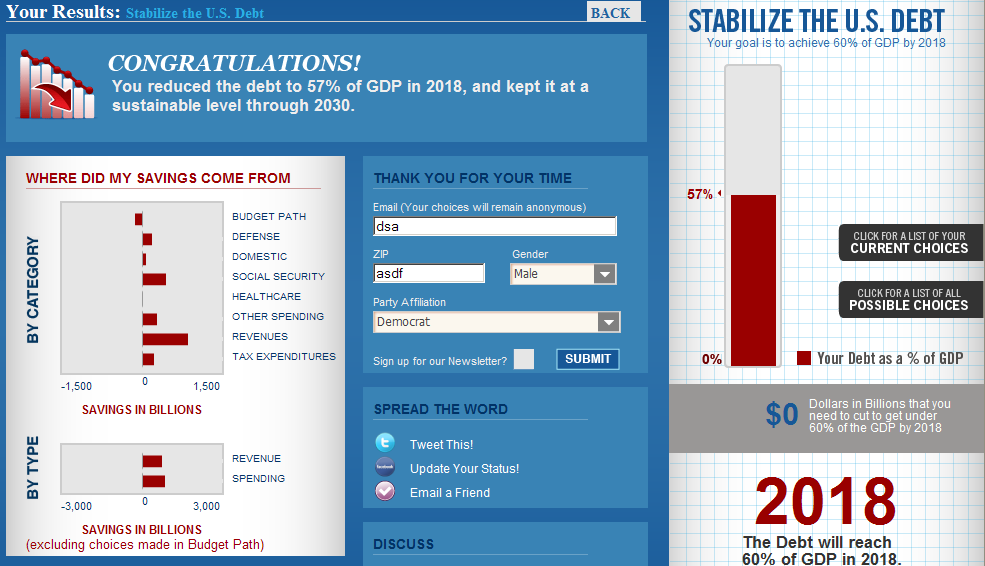JerichoHill
Bedrock of Knowledge
1. Click HERE
(http://crfb.org/stabilizethedebt/)
2. Play around and attempt to stabilize the debt
3. List your Solution and explain it.
(Note: CFRB is a non-partisan think-tank that's very concerned about our budget issues. They actually are non-partisan. Shocking)
JH's Solution:
It is obvious that I'm an urban economist. We tend to look at transportation and housing tax issues as highly distortionary in their current set up, so we'd want to correct those. I may have been too harsh on the military and could be convinced (in a debate) to drop the dependent exemption increase and add back in all non-troop level military cuts (cut 190 there, get 170 back into the military). It also seems obvious that if we are measuring inflation in a biased fashion, correcting that should be a non-partisan easy fix.
Changes under the spoiler tag.
Spending
Reduce Troops to 60,000 by 2015 (Afghan + Iraq)
-$350B
Enact Administration's Proposed Weapon System Cuts
-$30B
Cancel Missile Defense System
-$50B
Reverse "Grow the Army" Initiative
-$90B
Cancel TARP and Rescind Unused ARRA Funds
-$350B
Enact New Jobs Bill
$210B
Grow Regular Discretionary Spending with Inflation
$0
Eliminate Certain Outdated Programs
-$40B
Reduce Farm Subsidies
-$80B
Cut Earmarks in Half
-$80B
Increase Mass Transit Funding
$60B
Revenue
Allow All the Tax Cuts, Except for AMT Patches, to Expire
$480
Gradually Reduce Food Stamps Benefits to 2008 Levels
-100B
Freeze Average Unemployment Benefits at 2009 Levels
-$50B
Progressively Reduce Benefits, Protecting Low and Medium Earners
-$60B
Use An Alternate Measure of Inflation for COLAs
-$100B
Increase Years Used to Calculate Benefits
-$40B
Include all New State and Local Workers into SS
-$80B
Enact Medical Malpractice Reform
-$50B
Increase User Fees Across the Board
-$40B
Increase Gas Tax by 10 Cents per Gallon
-$80B
Gradually Increase Dependent Exemption by $3,500
$190B
Index Tax Code to Alternate Measure of Inflation
-$80B
Improve Tax Collection (Reduce Tax Gap)
-$20B
Convert Mortgage Interest Deduction to a 20% Credit
-$190B
Eliminate Subsidies for Biofuels
-$110B
Expand the EITC and Child Tax Credit
$90B
Extend "American Opportunity" College Tax Credit
$60B
Repeal Excise Tax on High-Cost Plans (Health Care)
$10B
(http://crfb.org/stabilizethedebt/)
2. Play around and attempt to stabilize the debt
3. List your Solution and explain it.
(Note: CFRB is a non-partisan think-tank that's very concerned about our budget issues. They actually are non-partisan. Shocking)
JH's Solution:
It is obvious that I'm an urban economist. We tend to look at transportation and housing tax issues as highly distortionary in their current set up, so we'd want to correct those. I may have been too harsh on the military and could be convinced (in a debate) to drop the dependent exemption increase and add back in all non-troop level military cuts (cut 190 there, get 170 back into the military). It also seems obvious that if we are measuring inflation in a biased fashion, correcting that should be a non-partisan easy fix.
Changes under the spoiler tag.
Spoiler :
Spending
Reduce Troops to 60,000 by 2015 (Afghan + Iraq)
-$350B
Enact Administration's Proposed Weapon System Cuts
-$30B
Cancel Missile Defense System
-$50B
Reverse "Grow the Army" Initiative
-$90B
Cancel TARP and Rescind Unused ARRA Funds
-$350B
Enact New Jobs Bill
$210B
Grow Regular Discretionary Spending with Inflation
$0
Eliminate Certain Outdated Programs
-$40B
Reduce Farm Subsidies
-$80B
Cut Earmarks in Half
-$80B
Increase Mass Transit Funding
$60B
Revenue
Allow All the Tax Cuts, Except for AMT Patches, to Expire
$480
Gradually Reduce Food Stamps Benefits to 2008 Levels
-100B
Freeze Average Unemployment Benefits at 2009 Levels
-$50B
Progressively Reduce Benefits, Protecting Low and Medium Earners
-$60B
Use An Alternate Measure of Inflation for COLAs
-$100B
Increase Years Used to Calculate Benefits
-$40B
Include all New State and Local Workers into SS
-$80B
Enact Medical Malpractice Reform
-$50B
Increase User Fees Across the Board
-$40B
Increase Gas Tax by 10 Cents per Gallon
-$80B
Gradually Increase Dependent Exemption by $3,500
$190B
Index Tax Code to Alternate Measure of Inflation
-$80B
Improve Tax Collection (Reduce Tax Gap)
-$20B
Convert Mortgage Interest Deduction to a 20% Credit
-$190B
Eliminate Subsidies for Biofuels
-$110B
Expand the EITC and Child Tax Credit
$90B
Extend "American Opportunity" College Tax Credit
$60B
Repeal Excise Tax on High-Cost Plans (Health Care)
$10B







